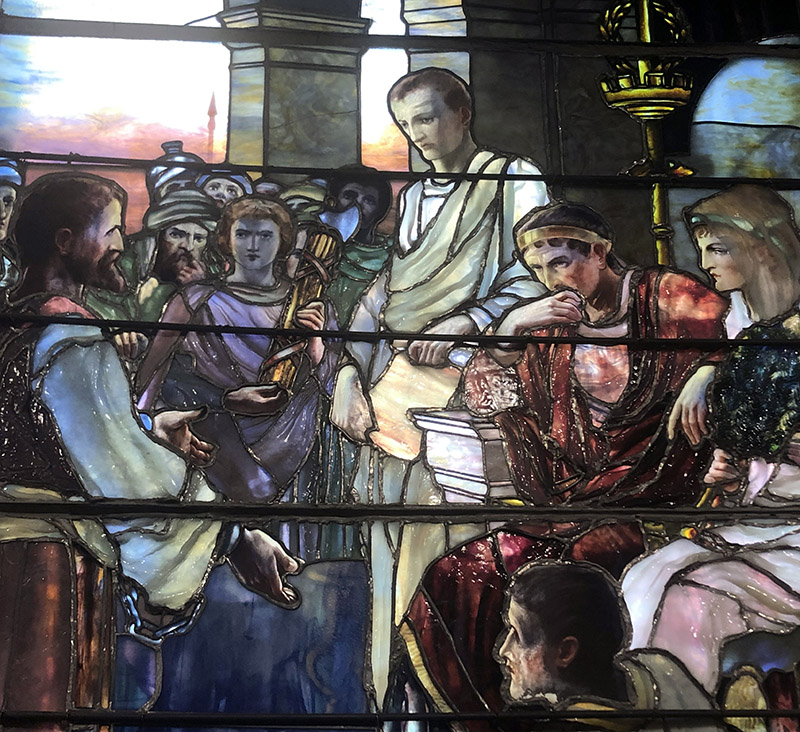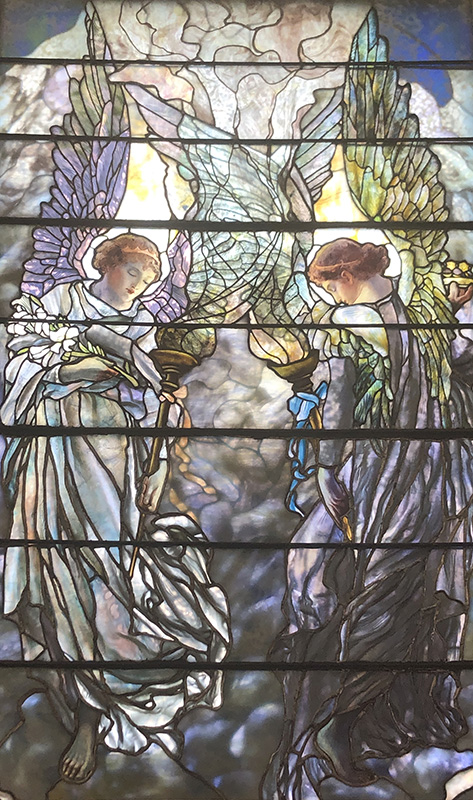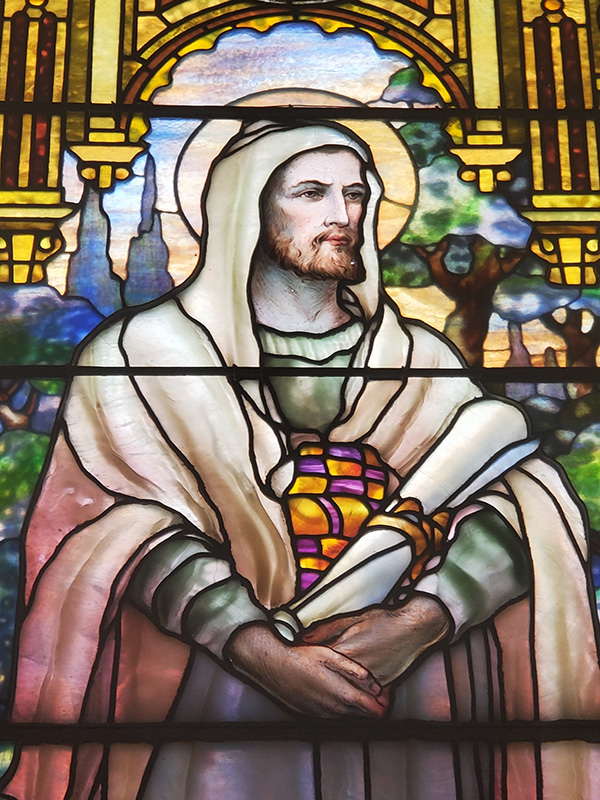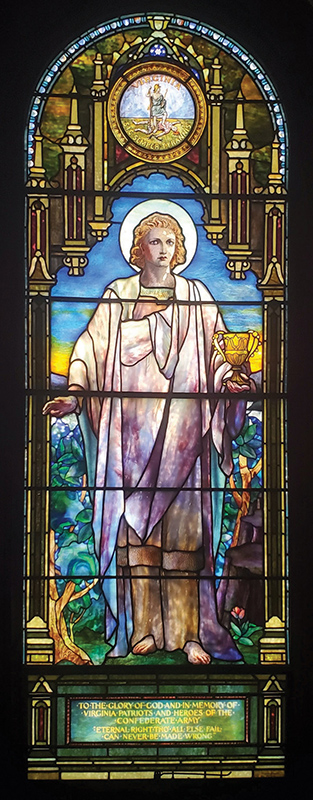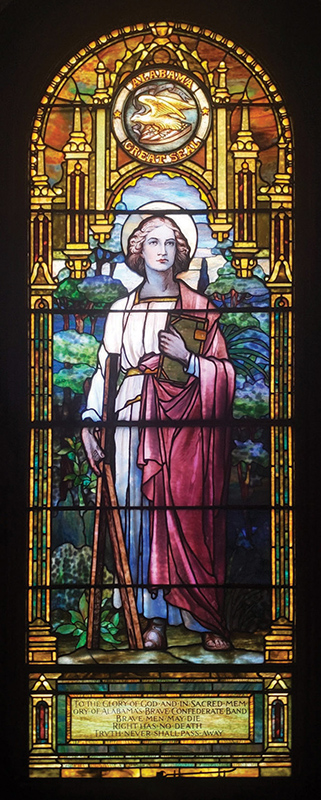Tiffany’s Confederacy Memorial Windows, 1889–1925
by Kayli Rideout
With support from a Decorative Arts Trust Summer Research Grant, I was able to spend time this summer in Richmond and Petersburg, VA, conducting research for my PhD dissertation. Though the Trust graciously extended the terms of the summer research grants due to the restrictions and difficulties of the COVID-19 pandemic, I felt compelled to make the trip somewhat urgently given that my dissertation focuses on Confederacy memorial windows produced by Tiffany Studios in the years between 1889 and 1925. As the capital of the Confederacy, Richmond is often at the center of the national conversation concerning the removal of Confederate monuments, a conversation that peaked this past summer. My research is far from complete, but with the support of the Trust I was able to photograph these windows in situ and speak with their custodians about the history of the windows in their respective sites.
St. Paul’s Episcopal Church in Richmond houses one of the earliest known Tiffany Confederacy memorial windows. Built in 1845, St. Paul’s has been called the “cathedral of the Confederacy” given its position in the Confederate capital and the high-ranking Confederate figures counted among its members. As the home church of Robert E. Lee and Jefferson Davis, St. Paul’s became a hotbed of activity in the years following the Civil War during a movement of Confederate commemoration known as the Lost Cause. Reportedly, Davis was attending a Sunday service at the church when he was notified that Lee’s army had given way and that Union forces were headed towards Richmond. As Elizabeth O’Leary, a historian and member of St. Paul’s History and Reconciliation Initiative, has explained, “through repeated telling, the narrative of the Confederacy’s evacuation and subsequent final week commenced at the church’s doorstep.”1
The church’s History and Reconciliation Initiative aims to acknowledge the historical role of the church in supporting the Confederacy, perpetuating racial and social injustice, and binding of the Confederate cause to theology, especially that of Protestant Evangelicalism. St. Paul’s support for the Confederate cause can be traced to the antebellum period but was visually manifested in the late 1890s, when the congregation commissioned the Tiffany Glass & Decorating Company of New York to design and install a stained-glass window commemorating the life of Jefferson Davis. The subjects of the commission, Paul the Apostle brought before King Herod Agrippa for the lower window (figure 1) and two Angels of Goodness and Mercy for the upper (figure 2), were selected after much correspondence between the Company and the church’s Memorial Committee. Without portraying Davis himself, the windows’ designs envision Davis as the Confederacy’s own persecuted apostle, promised sanctification and reward in his life after death.
The Davis memorial window is one of 19 known windows that Tiffany created in memory of the Confederacy, installed in Southern churches and universities during the height of Jim Crow in the years between 1889 and 1925. With the support of the Trust, I was able to visit 16 of those, the Davis memorial window and 15 windows in situ at Old Blandford Church in Petersburg, VA.
The visual program at Old Blandford Church is the most elaborate and expansive of all the known Confederacy memorials that Tiffany created, and my visit allowed me to learn more about the history of the site and the commission. In 1901, the Ladies Memorial Association, a Confederate memorial group of Petersburg residents, assumed care of Old Blandford, a pre-Revolution Anglican church that the Ladies intended to convert into a mortuary chapel and Confederate shrine. In hopes of restoring the chapel to its original plan, the Ladies aimed to install stained glass windows dedicated to the memory of Confederate soldiers from every Southern state. Records indicate that the Ladies were eager to enlist “Mr. Tiffany” from New York City, and to avoid dispute among the Ladies, the subject and theme of the window scheme reportedly was left to Tiffany’s discretion.2
A representative from the newly named Tiffany Studios was sent to survey the site and decided that there would be 14 windows—one to represent each of the 11 Confederate states and one each for Maryland, Arkansas, and Kentucky—as well as a lunette window commemorating the Petersburg Ladies. Kentucky’s Confederate memorial organization was unable to financially commit to the project, and records of the Ladies Memorial Association of Petersburg indicate that Tiffany Studios supplied an alternate window, a Cross of Jewels, as a gift to replace the vacated space.3 Each compass window was crafted in the Gothic Revival style with the state seal, a figure of one of Christ’s apostles, and an individualized inscription supplied by the state. The windows depicting South Carolina as St. Mark, Alabama as St. Andrew, and Virginia as St. John are some of the more visually rich examples of the way this commission married church, state, and the Confederate cause (figures 4 and 5). Few photographs exist, and my visit to the site allowed me to properly capture these windows.
My time in Richmond and Petersburg provided an invaluable contribution to my dissertation project and my understanding of the Lost Cause visual program. With the support of the Trust, I was afforded the opportunity to visit these sites and gain a greater understanding of several critical but understudied examples of Tiffany’s work. I was led to consider how, in Confederate memorial groups, Tiffany identified a desirous consumer base and a shared investment in memory making. Future research will continue to interrogate Tiffany’s engagement with the tradition of Confederate memory by recontextualizing the Studios’ work within the social, legal, and political landscape of the Jim Crow South.
1 Elizabeth O’Leary, “A Memorial to Those Who Made Her History: Material Acts of Remembrance at St. Paul’s, 1845-2004,” History and Reconciliation Initiative (Richmond, Virginia: St. Paul’s Episcopal Church, 2019), 9.
2 Nichols, Janet Bernard, Sketch of Old Blandford Church, 1957, (Reprinted by the Ladies Memorial Association, Petersburg, Virginia, 1990), 7.
3 Nichols, 7.
Kayli Rideout is a PhD candidate in the American and New England Studies Program at Boston University.
A print version of this article was published in The Magazine of the Decorative Arts Trust, one of our most popular member benefits. Join today!

